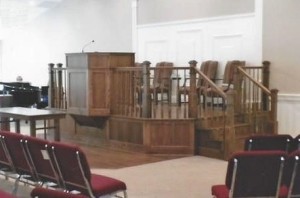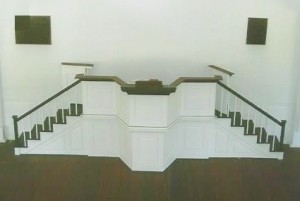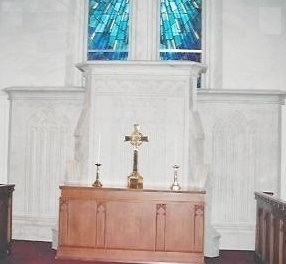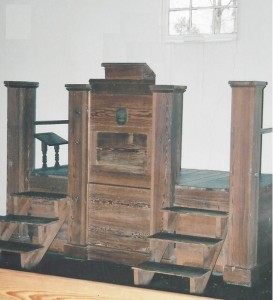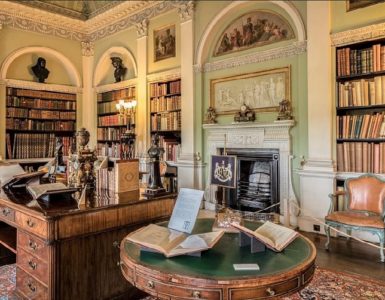The header picture shows the interior of an abandoned church in the mountains which dates to early in the nineteenth century. The pulpit is simple as are the pews. The piano appears to be a later edition given its awkward positioning. The pulpit is simple as are the interior finishes and pews. This article on pulpits is the first of a series that will be posted occasionally on Presbyterians of the Past to provide information about the design of churches. It is hoped that these brief topical studies will be helpful to church building committees as they design their worship facilities. One aspect of church design that will be emphasized is the simplicity of worship and the limited needs for a church building to accomplish administration of the Word and sacraments in a rightly ordered fashion.
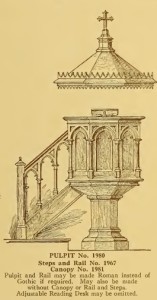 A key consideration for church design is the pulpit because from it the Bible’s message is proclaimed. John Knox’s First Buke of Discipline, 1560, provides a description of the fundamental needs for a suitable place of worship. The facility and furnishings should be such that they reflect the “majesty of the word of God,” are tasteful, large enough, and within the financial means of the congregation. A proper permanent church building should have entrance doors, weather tight windows (as much as was possible in sixteenth-century Scotland), a bell to call the people to services, a pulpite, (also spelled pulpit or pullpit), a basin for baptism, and tables for administration of the Lord’s Supper. Note that the “tables” for the Lord’s Supper are serving tables to which the communicants were called and seated to receive the elements. The physical requirements for worship are simple and may readily be adapted to the economic limitations of a congregation whether it is a flock meeting under a tent in an African jungle or a large church gathered in a modern air-conditioned facility in a major metropolis. A pulpit, as is seen in the photograph collection at the end of this article, might be made more substantial using great amounts of fine wood or even costly stone. However, the simplest pulpit is the outstretched arm and spread hand of a pastor holding his open Bible as he preaches God’s message.
A key consideration for church design is the pulpit because from it the Bible’s message is proclaimed. John Knox’s First Buke of Discipline, 1560, provides a description of the fundamental needs for a suitable place of worship. The facility and furnishings should be such that they reflect the “majesty of the word of God,” are tasteful, large enough, and within the financial means of the congregation. A proper permanent church building should have entrance doors, weather tight windows (as much as was possible in sixteenth-century Scotland), a bell to call the people to services, a pulpite, (also spelled pulpit or pullpit), a basin for baptism, and tables for administration of the Lord’s Supper. Note that the “tables” for the Lord’s Supper are serving tables to which the communicants were called and seated to receive the elements. The physical requirements for worship are simple and may readily be adapted to the economic limitations of a congregation whether it is a flock meeting under a tent in an African jungle or a large church gathered in a modern air-conditioned facility in a major metropolis. A pulpit, as is seen in the photograph collection at the end of this article, might be made more substantial using great amounts of fine wood or even costly stone. However, the simplest pulpit is the outstretched arm and spread hand of a pastor holding his open Bible as he preaches God’s message.
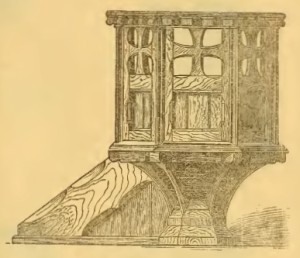 Pulpit designs have changed over the years since the Protestant Reformation, but the purpose of pulpits was and is to serve as a stand for the open Word of God and a symbol of Biblical authority and reverence for what God has revealed. The Bible on the pulpit and the sermon constitute the hub of worship with all other aspects revolving around the minister’s message from the Word and administration of the sacraments. The high elevation of some pulpits above their congregations in the days before electronic amplification provided better acoustics for the minister’s voice to reach all in attendance, but the tall pulpit also drew the attention of church members to the preacher and the Word he was expositing for their spiritual nourishment. A high pulpit means that the minister can not only be seen but also see. A fundamental principle of good communication is that the speaker and his listeners should have eye contact and be engaged. The glance of a minister as he scans the individuals in his church provides him with feedback regarding whether or not the Lord’s message is making contact; a member’s nod, another’s contemplative appearance, a recently widowed woman’s apparent joy, or maybe even the tears of one whose son died in a distant war reassure the pastor that the Word is not returning unto its Author void. The personal connection through eye contact is important for the communication of God’s Word and the minister delivering the message from the Bible directs the congregation’s attention to it’s Author.
Pulpit designs have changed over the years since the Protestant Reformation, but the purpose of pulpits was and is to serve as a stand for the open Word of God and a symbol of Biblical authority and reverence for what God has revealed. The Bible on the pulpit and the sermon constitute the hub of worship with all other aspects revolving around the minister’s message from the Word and administration of the sacraments. The high elevation of some pulpits above their congregations in the days before electronic amplification provided better acoustics for the minister’s voice to reach all in attendance, but the tall pulpit also drew the attention of church members to the preacher and the Word he was expositing for their spiritual nourishment. A high pulpit means that the minister can not only be seen but also see. A fundamental principle of good communication is that the speaker and his listeners should have eye contact and be engaged. The glance of a minister as he scans the individuals in his church provides him with feedback regarding whether or not the Lord’s message is making contact; a member’s nod, another’s contemplative appearance, a recently widowed woman’s apparent joy, or maybe even the tears of one whose son died in a distant war reassure the pastor that the Word is not returning unto its Author void. The personal connection through eye contact is important for the communication of God’s Word and the minister delivering the message from the Bible directs the congregation’s attention to it’s Author.
 Because the message of God through his servants preaching the Bible is fundamental for worship, sixteenth-century churches often had Bibles chained to their pulpits not only to show the necessity of the Word for worship but also to assure that a copy of the Bible would be available for use. Books were expensive in the era and Bibles were particularly costly, so not all individuals could afford a copy and the theft of a Bible was a real concern because churches were often left unlocked. It might be better if copies of the Bible were more costly today because it could yield a greater respect for God’s revelation of his grace of redemption. American Christians sometimes speak lightly about the many Bibles they have scattered around their homes, but there are many brethren in the world that would love to have just one copy of God’s Word.
Because the message of God through his servants preaching the Bible is fundamental for worship, sixteenth-century churches often had Bibles chained to their pulpits not only to show the necessity of the Word for worship but also to assure that a copy of the Bible would be available for use. Books were expensive in the era and Bibles were particularly costly, so not all individuals could afford a copy and the theft of a Bible was a real concern because churches were often left unlocked. It might be better if copies of the Bible were more costly today because it could yield a greater respect for God’s revelation of his grace of redemption. American Christians sometimes speak lightly about the many Bibles they have scattered around their homes, but there are many brethren in the world that would love to have just one copy of God’s Word.
The center of confessional Protestant worship is the Word of God and pulpit design should provide a physical impression of sola Scriptura as it draws attention to the Book as its message is preached. Thus, a pulpit, whether it is the preacher’s open hand, a lectern, an ornate masterpiece of finish carpentry, or a mass of hewn stone is essential for worship and must be the hub of any service that teaches one how to glorify and enjoy the Lord God.
Barry Waugh
The Pictures
The pulpits in this collection of photographs may or may not be original to the church buildings. All the photographs were taken by the author of this article.
(A) A church in the Atlanta area has this lovely wood pulpit. It has a bit of elevation for maintaining two-way eye contact and the use of rails and spindles around the platform allows those seated in the congregation and on the platform to see each other. The baptismal font is to the left of the pulpit and the communion table is at center for administering both the Word and sacraments.
(B) The extended stairs to both sides of this pulpit gives it an impressive presence. Its high elevation allows the minister to view his flock on the floor level clearly, but having eye contact with the gallery, which is a large one in this case, is more difficult.
(C) This marble pulpit located in the chapel of a Presbyterian church in South Carolina may take pulpit design to its logical conclusion if one believes pulpit materials must reflect one’s view of the importance of the Bible with respect to the material used for construction. There is nothing more substantial or precious than the sixty-six books of Scripture, so why not show this in the use of a high density and pricey material like marble. The pulpit in the photograph was moved to the chapel when it was replaced by another marble pulpit in the church sanctuary. When I visited the church one Sunday for worship, I was looking over the marble pulpit in the sanctuary. I asked one of the ushers if he knew how much it weighed, to which he responded he did not. He did tell me that when the pulpit was set in the sanctuary it was quite a complex and costly project moving it into the building and setting it on its firm foundation. Could a marble pulpit be carrying a good idea too far?
 (D) The wood and millwork surrounded pulpit pictured here is located in a seventeenth century meetinghouse in New England. It is high with stairs opening to the front and the seat next to the entrance for the stairs is where the reader who “lined out” the Psalms for worship was seated. The reader would read a line, and then the congregation would repeat it as they sang the Psalm.
(D) The wood and millwork surrounded pulpit pictured here is located in a seventeenth century meetinghouse in New England. It is high with stairs opening to the front and the seat next to the entrance for the stairs is where the reader who “lined out” the Psalms for worship was seated. The reader would read a line, and then the congregation would repeat it as they sang the Psalm.
(E) In the country, this simple, rough-cut pulpit shows the use of common lumber in its construction. Note the window behind the pulpit for light and the sloped and prominent surface for the Bible. Whether the pulpit is fine marble or rustic wood, the purpose is the same.
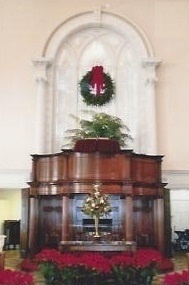 (F) Right-In Georgia, this high pulpit with its fine hardwood construction is impressive and provides a clear view for the shepherd to see his flock and for them to see him. The columns supporting the elevated pulpit floor give the impression of strength and echo the architectural columns of the building’s portico. Beneath the elevated floor and behind the two central columns are seats for elders when the sacraments are administered.
(F) Right-In Georgia, this high pulpit with its fine hardwood construction is impressive and provides a clear view for the shepherd to see his flock and for them to see him. The columns supporting the elevated pulpit floor give the impression of strength and echo the architectural columns of the building’s portico. Beneath the elevated floor and behind the two central columns are seats for elders when the sacraments are administered.
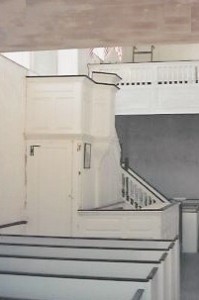 (G) In rural New Jersey this high pulpit in an old church has what appears to be a tight-fitting area for the preacher to stand. Note the staircase on the far side in the image. At the time the photograph was taken the church was closed for renovations; the picture was taken through a window.
(G) In rural New Jersey this high pulpit in an old church has what appears to be a tight-fitting area for the preacher to stand. Note the staircase on the far side in the image. At the time the photograph was taken the church was closed for renovations; the picture was taken through a window.
 (H) The pulpit seen here with its lovely oak chalice like construction was given to a seminary because its church no longer wanted to have it in its sanctuary. A Presbyterian church in Tennessee that was under construction rescued the abandoned pulpit and installed it in its new building with the help of a member that constructed the pedestal and stairs. It provides good height for the minister to see his sheep and be seen in return.
(H) The pulpit seen here with its lovely oak chalice like construction was given to a seminary because its church no longer wanted to have it in its sanctuary. A Presbyterian church in Tennessee that was under construction rescued the abandoned pulpit and installed it in its new building with the help of a member that constructed the pedestal and stairs. It provides good height for the minister to see his sheep and be seen in return.
Sources—John Knox’s The First Buke of Discipline, 1560, is the one found in The Works of John Knox; Collected and Edited by David Laing, vol. 2, Edinburgh: The Woodrow Society, 1848; the information regarding the architecture and furniture of the church building was found on page 252. Readers of the old Scottish text might find the glossary at the end of the volume helpful for deciphering some of the sixteenth-century words. Note that inconsistency of spelling was not uncommon in sixteenth century publishing. Also, George Hay’s The Architecture of Scottish Post-Reformation Churches, 1560-1843, Oxford: Oxford University Press, 1957, was helpful; the section on pulpits is found on pages 184-190.



